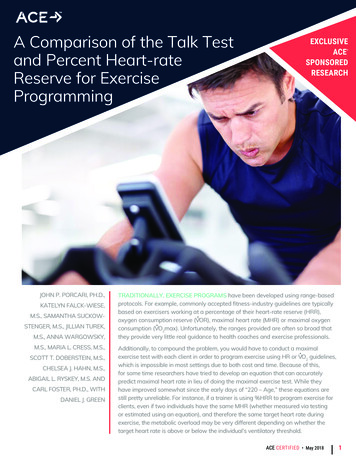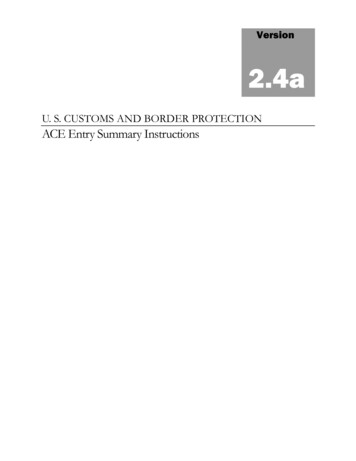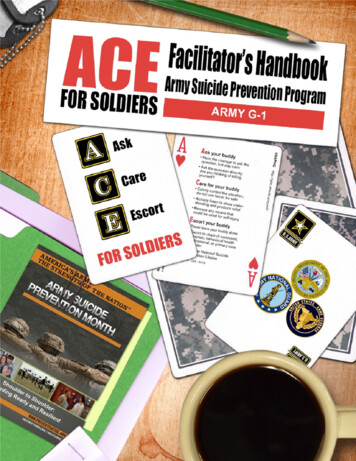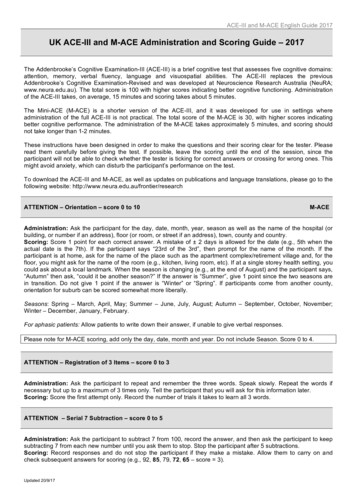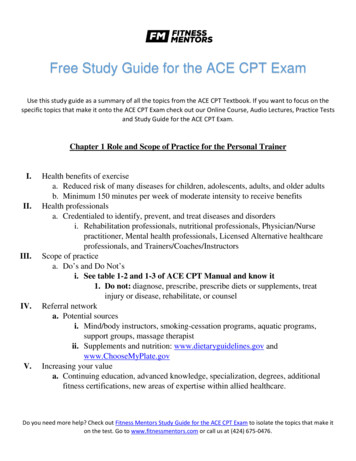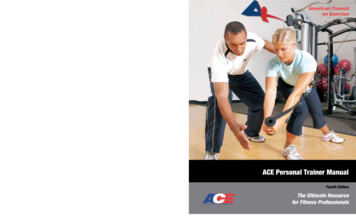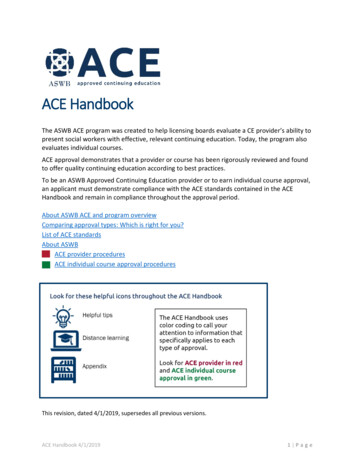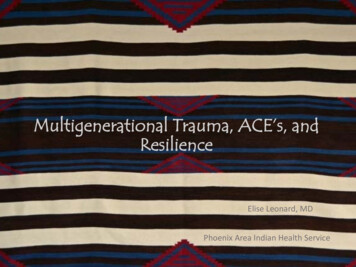
Transcription
Multigenerational Trauma, ACE’s, andResilienceElise Leonard, MDPhoenix Area Indian Health Service
a tweet from Lin-Manuel Miranda, 6 amGmorning.Breathe deep.That hitch in your breath is a record scratch.That throbbing in your temple is the bass, andyou control the volume knob.The scars in your mind and your heart aregrooves that run deep.YOUR music. YOUR heart. YOUR life.You got the aux cord.Bump it
Introduction how do families and communities successfullywrestle with the challenges of past and presenttrauma? how can we use our knowledge about the effectsof trauma on mental and physical health to guidehealing? what is the connection between mutigenerational(intergenerational, historical) trauma and adversechildhood experiences (ACEs)?
Brief review of ACEs concept from 1995 to 1997, over 17,000 KaiserPermanente HMO members completed a surveyof Adverse Childhood Experiences (ACEs) 75% white, all adults two-thirds reported one ACE, 20% reportedthree or moreRelationship of Childhood Abuse and Household Dysfunction to Many of the Leading Causes of Death in AdultsFelitti, Vincent J et al. American Journal of Preventive Medicine May 1998. Volume 14, Issue 4, 245-258
Dose-response relationship found Alcoholism and alcohol abuse Risk for intimate partner violence Chronic obstructive pulmonarydisease Multiple sexual partners Depression Fetal death Health-related quality of life Illicit drug use Ischemic heart disease Liver disease Poor work performance Financial stress Sexually transmitted diseases Smoking Suicide attempts Unintended pregnancies Early initiation of smoking Early initiation of sexual activity Adolescent pregnancy Risk for sexual violence Poor academic achievementRelationship of Childhood Abuse and Household Dysfunction to Many of the Leading Causes of Death in AdultsFelitti, Vincent J et al. American Journal of Preventive Medicine May 1998. Volume 14, Issue 4, 245-258
How do ACEs cause these problems? not fully understood stress hormones may continue to bedysregulated after early stress epigenetic factors (needs further study) increased risky behaviors may berelated to decreased safety-seeking
ACE questionnaire break complete the ACE questionnaire on thetable (optional) you do not need to share your score
CDC: national ACEs data
CDC: national ACEs data
ACEs and caregivers original ACEs study: 12.5% of the Kaiser group hada score of four or more California 2011 and 2013 statewide adult data: 16%had a score of 4 or more survey of California in-home care providers at aconference: 54.5% had a score of 4 or more survey of child service providers in the NE hadhigher scores than their overall demographic groupIt’s not surprising: CA home visitors, like other caregivers, have high ACE scores.Stevens, Jane. www.ACEsConnection.com, blog 8/10/2016Prevalence of Adverse Childhood Experiences (ACEs) Among Child Service Providers. Esaki N andLarkin H. Families in Society: The Journal of Contemporary Social Services 2013, 94(1), 31–37
By age group, WA stateDistinct Contributions of Adverse Childhood Experiences and Resilience Resources: A Cohort Analysis ofAdult Physical and Mental Health Logan-Greene P et al. Soc Work Health Care. 2014; 53(8): 776–797.
By age group, WA stateDistinct Contributions of Adverse Childhood Experiences and Resilience Resources: A Cohort Analysis ofAdult Physical and Mental Health Logan-Greene P et al. Soc Work Health Care. 2014; 53(8): 776–797.
Children: Arizona and the nation
National Survey of Children’s Health2011-2012: ACEs in children AI/AN children compared to non-Hispanic white(NHW) children twice as likely to have 2 ACEs two and a half times as likely to have 3 ACEs three times as likely to have 4 ACEs depression, anxiety, and ADHD much higher forAI/AN children with 3 ACEs than with 0 or 1 this is a great study-citation belowAdverse Childhood Experiences among American Indian/Alaska Native Children: The 2011-2012 National Survey ofChildren's Health. Kenney M and Singh G. Scientifica (Cairo). Publiched online 2016 Jul 26.doi: https://dx.doi.org/10.1155%2F2016%2F7424239
Factors associated with higher ACEsscore in AI/AN children low birth weight single mother, no father present income at or under the Federal poverty level adult without high school diploma non-supportive neighborhoodAdverse Childhood Experiences among American Indian/Alaska Native Children: The 2011-2012 National Survey ofChildren's Health. Kenney M and Singh G. Scientifica (Cairo). Publiched online 2016 Jul 26.doi: https://dx.doi.org/10.1155%2F2016%2F7424239
ACEs effects start early effect of ACEs on physical health is seen inchildhood asthma, obesity kids with two or more ACEs were almost 3 times aslikely to repeat a grade in school as kids with 0Adverse Childhood Experiences: Assessing the Impact on Health and School Engagement and theMitigating Role of Resilience. Bethell, CD et al. Health Affairs 33, NO. 12 (2014): 2106–2115
Stressors add up: all ages people with more adverse childhood events (ACEs)tend to continue having stressful events in life cumulative disadvantages “compile and compound”,helping to perpetuate trauma and contributing totransmission to future generationsStress and Health: Major Findings and Policy Implications Thoits, PA. Journal of Health andSocial Behavior. 2010; 51(S) S41–S53 245-258
Other stressors discrimination stress is also associated withnumerous physical and mental health problems racial and ethnic minorities sexual minorities women other devalued groups low education, low incomeStress and Health: Major Findings and Policy Implications Thoits, PA. Journal of Health andSocial Behavior. 2010; 51(S) S41–S53 245-258
Intergenerational trauma “ A collective complex trauma inflicted on agroup of people who share a specific groupidentity or affiliation- ethnicity, nationality,religious affiliation. It is the legacy of numerous traumatic events acommunity experiences over generations andencompasses the psychological and socialresponses to such events.”University of Calgary, Intervention to Address Intergenerational Trauma: Overcoming, Resisting,and Preventing Structural Violence. 2012
Intergenerational trauma connections mental health problems and violence substance abuse (BraveHeart, 2003) cultural alienation and depression (Menzies,1999) hopelessness (Strickland, 2006)University of Calgary, Intervention to Address Intergenerational Trauma: Overcoming, Resisting,and Preventing Structural Violence. 2012
Trauma and view of time, place,relationships having a safe “home base” but visiting a countrywhere war erupts strong sense of seeking safety (“I want to go home!”) past is intact, future is fine if safety is reached “home base” is still safe and reliable attachments are a source of strength
Trauma and view of time, place,relationships being drafted to a war seeking full safety (“I want to go home!”) must beabandoned for survival avoiding medium-risk behaviors can seem silly the past is real but painful to recall, the future mayor may not exist attachments are intense in the moment, but loss isoverwhelming true grieving leaves you vulnerable
Trauma and view of time, place,relationships after an entire community is traumatized “home base” may not feel safe any more, or it maybe gone (relocation) it may still feel silly to avoid non-immediate danger(health practices, seatbelts) the expectation of loss may be prominent inattachments, no truly “safe” place to grieve the past may be too painful to connect with difficult to envision/plan the future
Pillars of healing the Aboriginal Healing Foundation was set upin 1998 to address the legacy of abuses in theCanadian residential school system in 2006 they released the report, “PromisingHealing Practices” which defined Pillars ofHealingUniversity of Calgary, Intervention to Address Intergenerational Trauma: Overcoming, Resisting,and Preventing Structural Violence. 2012
Pillar 1: Legacy Education teaching the history builds a sharedunderstanding of experiences, allows traumaresponses to be seen as a result of externalforces builds self-reflection, connection, compassion strengthens youth/adult relationships –enhancing sense of safety, restoring continuityof time senseUniversity of Calgary, Intervention to Address Intergenerational Trauma: Overcoming, Resisting,and Preventing Structural Violence. 2012
Pillar 2: Cultural Interventions any type of community activity connectingmembers through identity, practice, tradition ceremony arts food preparation language fosters elder/youth connection (past-presentfuture)University of Calgary, Intervention to Address Intergenerational Trauma: Overcoming, Resisting,and Preventing Structural Violence. 2012
Pillar 3: Therapeutic Interventions these address a specific health outcome orcommunity problem substance abuse, mental health problems interpersonal violence based on traditional practices alone or integrated into medical care, school orlegal interventionsUniversity of Calgary, Intervention to Address Intergenerational Trauma: Overcoming, Resisting,and Preventing Structural Violence. 2012
Resilience factors: individual sense of mastery, self-esteem, and perceivedsocial support self-reflection, life satisfaction good sleep! people with higher ACEs report more sleep problemswhich may be a part of how health is affected infants of women with higher ACEs also have moresleep disordersStress and Health: Major Findings and Policy Implications Thoits, PA. Journal of Health andSocial Behavior. 2010; 51(S) S41–S53 245-258Kajeepeta S, Gelaye B, Jackson CL, Williams MA. Adverse childhood experiences are associated with adultsleep disorders: a systematic review. Sleep medicine. 2015;16(3):320-330.
Resilience factors: youth having a good relationship with at least oneadult having good communication skills believing that the future is positive these factors can be built and strengthened
Resilience factors: youth these factors predicted better school engagementdespite ACEs score “staying calm and in control when faced with a challenge” having a medical homeAdverse Childhood Experiences: Assessing the Impact on Health and School Engagement and theMitigating Role of Resilience. Bethell, CD et al. Health Affairs 33, NO. 12 (2014): 2106–2115
Brief Resilience Scale (BRS) break add up all results for a range of 6 to 30 you do not need to share your score
Resilience factors: communityKulig J et al. Community Resiliency: Emerging Theoretical Insights.JOURNAL OF COMMUNITY PSYCHOLOGY, Vol. 41, No. 6, 758–775 (2013)
Resilience factors: community 15-item scale, each scored 1 to 5 (not at all tovery much) for possible 75 points items ‘d’ and ‘g’ are scored 5 to 1 (negativeresilience factors)Kulig J et al. Community Resiliency: Emerging Theoretical Insights.JOURNAL OF COMMUNITY PSYCHOLOGY, Vol. 41, No. 6, 758–775 (2013)
Resilience factors: community strong leaders who listen to residents positive changes can happen when a problem occurs we are capable ofdealing with it sense of pride in communityKulig J et al. Community Resiliency: Emerging Theoretical Insights.JOURNAL OF COMMUNITY PSYCHOLOGY, Vol. 41, No. 6, 758–775 (2013)
Summary multigenerational trauma connects to increasedadverse childhood experiences ACEs drive worse health, substance abuse andthus perpetuate loss/trauma healing needs to occur in the context ofrelationships and community
Pillars of healing the Aboriginal Healing Foundation was set up in 1998 to address the legacy of abuses in the Canadian residential school system in 2006 they released the report, "Promising Healing Practices" which defined Pillars of Healing University of Calgary, Intervention to Address Intergenerational Trauma: Overcoming, Resisting,


